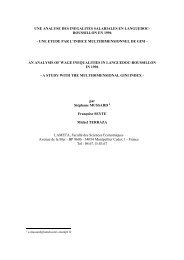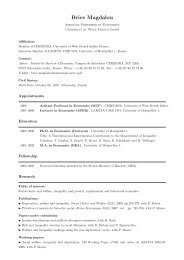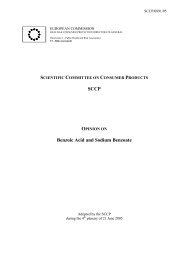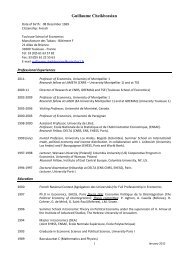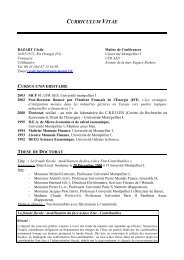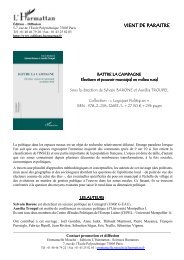COLLECTIVE INTEREST VS - Lameta
COLLECTIVE INTEREST VS - Lameta
COLLECTIVE INTEREST VS - Lameta
Create successful ePaper yourself
Turn your PDF publications into a flip-book with our unique Google optimized e-Paper software.
The aim is to obtain a specific list of behaviours (‘ 1 ,…,‘ i ,…,‘ n ), different from theprevious list ( 1 ,…, i ,…, n ), and which is now likely to maximise W. There is noinner contradiction in this description. Nevertheless, this reasoning is specific to thecollective level of analysis: we talk of collective interest (W), assessing the result of allindividual behaviours together. But the actual policies are to be enforced at theindividual level: the new system of individual incentives is designed so that the newindividual action ’ i is distinct from i , given that individuals keep on seeking theirindividual interest. This simply means that this design has recomputed the actualindividual interest in some utility V i , indeed distinct from U i .Let us summarize. As long as all individuals seek their own interest (U i ) i N , they donot necessarily seek the greatest collective interest W. If a new system of incentivesmanages to reorientate individual interests into (V i ) i N , which is likely to be differentfrom the previous list (U i ) i N , then individuals seeking their new interests (V i ) i N willeventually maximise W. In other words, there exist two kinds of individual interestfor Bentham. We will now call U i the self-defined interest for individual i; and V i thecollectivity-defined interest for individual i. Self-defined interest does not strictlyimply egoism, but a restriction of relevant information for defining one‘s individualinterest. Collectivity-defined interest does not imply altruism, but an extension ofadmissible information to collective states for defining one‘s individual interest.As a preliminary conclusion, we claim that, if no contradiction lies between the ‗is‘and the ‗ought‘ in general, the key issue lies rather in the ambiguity over the individual‗ought‘. When they merge, an analytical continuity between the individual and thecollective level should hold. When they do not do so spontaneously, continuity isonly restored by the collectively-defined interest V i . The definition and the status ofthe latter hence ought to be justified since it eventually derives from a technologicalrelation between individual behaviours. If the ethical link between individual andcollective interests appears clearly in Bentham‘s doctrine, the whole theory can beconsistent only if the positive link between them is also made explicit.Ethical link between individual and collective interestsThe ethical link between the individual interest and the collective interest establishedby Bentham respects the two following criteria: the principle of valuing individualinterests for themselves and the rejection of natural law and fundamental rights (SeeCot 1993). It is, firstly, based on the following condition: individual interests are theonly elements from which collective welfare can be derived—this defines Bentham‘s11






